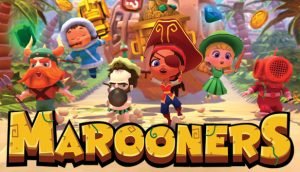Borderlands 3 is a first-person looter shooter that tries to build off of previous entries in the franchise but winds up being the worst of the series.
Performance and Graphics
When I first launched Borderlands 3, I played on an Nvidia 1070 GPU that struggled to run it on high settings. It ran okay, once I lowered the graphics, but it looked terrible. I didn’t play it again until I had a new GPU, a 3070. With this, I was able to run it on max settings and was shocked to find out the graphics don’t look much better. It drops ~60 fps for a marginal increase in graphical quality. While playing, I experienced occasional stutters and frame drops, inexcusable for a AAA game running on top-of-the-line hardware.
The general look of Borderlands 3 is a garish mess of oversaturated colors and excessive visual effects. After playing for only a short time, it hurt to look at all the flashing lights and bright colors. I had to turn the brightness down to its lowest setting just to play normally, although more subdued sections then became too dark. The texture quality isn’t awful, but it only looks marginally better than previous games in the series. Borderlands 2 is seven years older, yet I prefer its graphics to BL3 due to the more muted color scheme. The final bothersome design choice I noticed was the decision to make half of the guns huge. The biggest weapons can block out almost a third of the screen. It got to the point where I was using smaller, weaker ones simply because I could see better with them.
Audio
One area where BL3 is strong, relative to the rest of the game, is its sound. The music is a bit forgettable, but it does its job of setting the tone of each encounter. Similarly, the sound design is acceptable. It’s not exceptional, but there isn’t much to criticize either. None of the general sound effects stick out; they all play their part in creating a decent, albeit generic, atmosphere. Unfortunately, the potential for a solid atmosphere is ruined by the obnoxious voice acting. Don’t get me wrong, the cast list is full of top-tier actors, but their performances are hindered by what I can only assume is dreadful direction. Every character is voiced with the same style and cadence. Sure, a consistent tone is good to have, but it’s so invariable that it becomes hard to tell some people apart from each other. When combined with the abysmal dialogue, it’s a recipe for disaster.
Writing
Like its predecessors, it struggles with storytelling and writing. The plot is entirely forgettable and has no business being so prominent. It’s only there to push the player from one setting to another, yet the studio seems to think it’s one of the game’s main strengths. Maybe it plays better to a teenage audience, but I doubt it. Most of each characters’ dialogue sounds like a 40-year-old man trying to be hip, with what’s left consisting of dry exposition. While the comedy in earlier Borderlands games was never good, it was a lot more tolerable. In this title, they ramp up the “random” humor to the point that it becomes its worst quality. Before this, only a handful of characters fit this awful archetype, but BL3 ups the ante by making most NPCs unbearably annoying.
Gameplay – Combat
Going into BL3, I expected the combat to be roughly the same as the earlier games but polished up a little bit, maybe with a few new bells and whistles. Initially, my expectations were met: you have the same basic looter-shooter, action RPG gunplay, but with the addition of selective fire capabilities. Selective fire allows you to switch certain guns from automatic to semi-automatic to burst fire and sometimes to switch between firing bullets or rockets. It’s a simple mechanic, but it’s a clear upgrade over BL3‘s predecessors. The issues only begin to crop up when you hit the mid-game. Enemies start having a little too much health around this time, and it only gets worse. By the time I made it to the final boss, standard enemies had gone from being killed in a couple of seconds to ten or more. The one caveat is that I managed to find an extremely overpowered gun halfway through the game that was still my best weapon at the end. Unsurprisingly, it was the one I had the most fun with because it felt useful, especially when other guns, that were supposed to be significantly better, struggled to kill anyone. This problem was made more apparent by the piles and piles of weapons that enemies drop. Every fight ends with five minutes of sifting through garbage to find the best gun, only to discover that it deals 1% more damage than what you already have. It’s a mind-numbing experience that had me wishing the game would end soon.
NPC behavior is an issue that isn’t as major as the gunplay but is still a clear negative. The awful AI from previous titles has been regrettably carried over. The vast majority of enemies can be grouped into three categories: generic foot soldiers that run to cover then stand still shooting, monsters or humans with melee attacks that charge at you, and heavily armored supersoldiers that slowly walk towards you while shooting. There’s no strategy to their movements, and worst of all, there’s no variety. Everyone behaves the same, regardless of the situation they’re in. If foot soldiers can’t find cover, they simply stand in the open until you kill them. I suspect the braindead AI is the reason for the excessive usage of bullet-sponge enemies or vice versa. Regardless of the cause, it results in bland, unengaging combat in a game that is sorely lacking anything that can hold your attention.
Gameplay – RPG Mechanics
Once again, BL3 fails to meaningfully improve on a long-running weakness in the franchise; this time, it’s the characters’ skill trees. They’ve always been rudimentary, typically amounting to small numerical bonuses that boost different statistics but rarely give your character a unique playstyle. For example, the “Operative” character in BL3 has the option to invest skill points in three skill trees: one focused on shields and survivability, one that boosts your mobility and damage, and one that improves your clone ability and grenades. The issue is that, no matter which tree you invest in, the results are underwhelming. You can get some bonus damage, some movement speed, some extra shields, but it’s all just numbers. You get a few new abilities, but most of your skill points go towards simple stat boosts. Leveling feels impactful at first, but your character’s playstyle has been established after only a few levels, and it won’t change much going forward, even if you reset all your skill points.
Gameplay – Story Progression and Exploration
As you make your way through BL3, you explore a decent variety of locales. They don’t feel unique in terms of gameplay, but each has a different style that sets them apart, typically regarding the mission’s plot points. One location might be a wide-open wasteland where you have to drive everywhere while fighting bandits, while another could be a small swamp full of alien creatures. These are all nice touches that would complement a better game, but here, they are just a reminder of unrealized potential.
Surprisingly, one of the most frustrating parts of BL3 is the map. For some godforsaken reason, Gearbox decided that it should be divided into layers based on elevation, and that every layer should be displayed at once. The result is a 3D map shown from a top-down perspective. It’s utterly incomprehensible, most egregiously in the ship that serves as your base of operations. That area is shockingly difficult to navigate, thanks to having four levels that overlap on the main map. Having the ability to toggle between different elevations is a simple fix that would make exploration and navigation more accessible and less of a chore.
When you aren’t fighting the world map, you’re completing missions and progressing through the story. Unfortunately, even these core elements aren’t safe from major and minor annoyances. For starters, you have the existence of required side-missions. They aren’t technically necessary, but you eventually hit a point where you aren’t at a high enough level to do the main mission unless you complete some side objectives. This shouldn’t be a problem for players that are having fun, as they will most likely finish a handful of side-quests before they hit this point, but it was an arbitrary hurdle for me because I couldn’t bring myself to seek out additional content to complete when the main missions were already so boring. The more annoying mission-related drawback is the heavy usage of mandatory vehicular combat sections. The driving mechanics have been unchanged since the first game, yet for some reason, Gearbox thinks this is the best driving has ever felt in Borderlands. First off, you can’t turn your car by pressing left or right; you turn by looking in the direction you want to go. It’s an awful control scheme that creates pointless difficulties when trying to pull off driving maneuvers that would be simple in most other games. Secondly, vehicles have low health and only heal if you don’t take any damage for five to ten seconds. This leads to combat sequences that require you to hide after every fight, throwing off the flow of the mission. All in all, driving adds nothing but tedium to BL3, and it’s appalling that it shows up as often as it does.
Verdict
BL3 simply isn’t fun. It has the potential to be good, but it’s crippled by problems that are too numerous for a game of this size and budget. It was a chore to finish, and I struggle to compliment any aspect of it. The story was laughable, the gameplay was bland, and the visuals were lackluster. When you factor in the AAA price tag of $60, it’s a tough pill to swallow, given that so many better games are available for half that price. Maybe I could recommend it to huge fans of the franchise, but even then, it feels like the worst entry in the series. For the average action RPG fan, this is an obvious skip.




